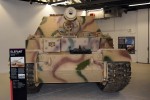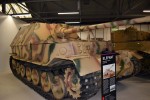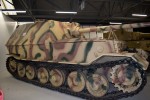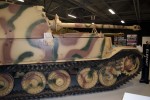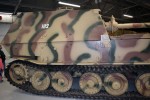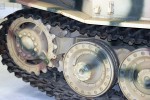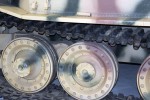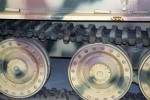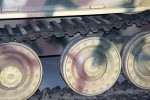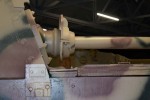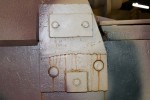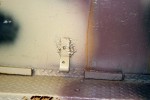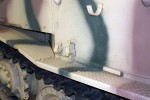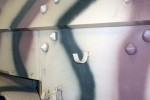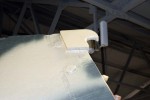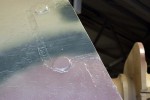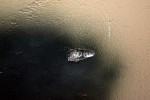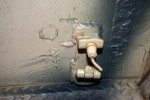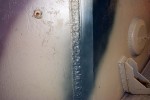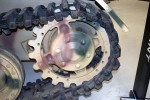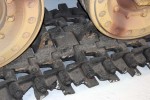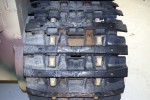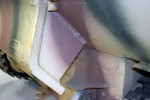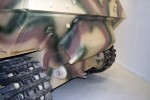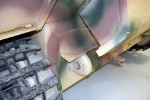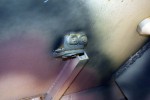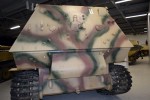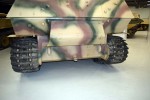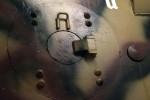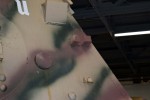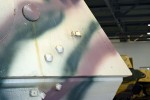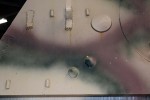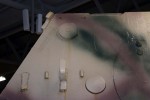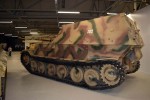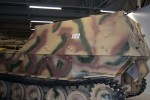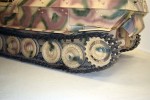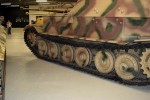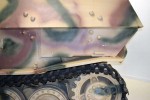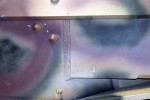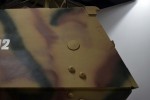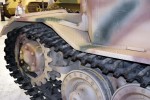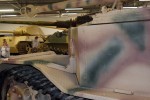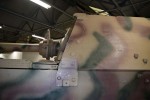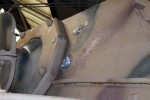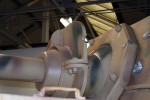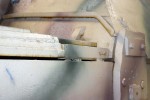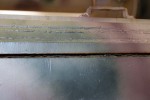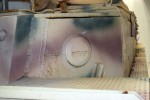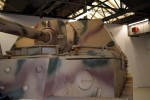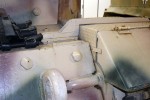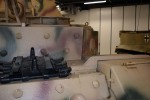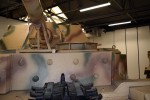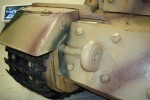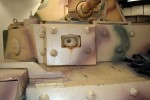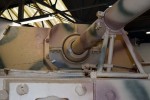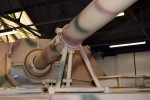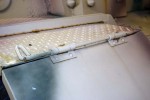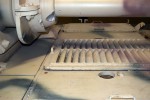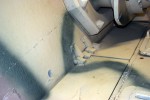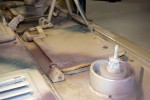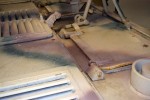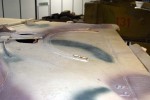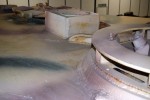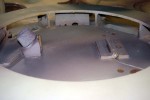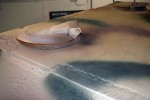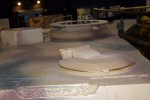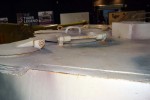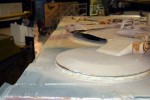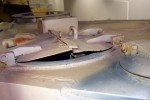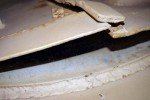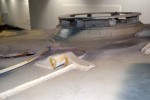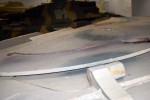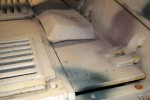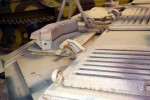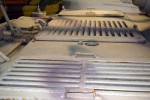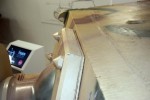1⁄1Elefant SdKfz 184
21
Comments
ELEFANT : GUN, ASSAULT, SELF PROPELLED, SDKFZ 184 (E2017.689)
THE FOLLOWING TEXT IS AS PROVIDED BY BOVINGTON TANK MUSEUM
Description
Originally known as the Ferdinand, then later renamed Elefant, 90 of this heavily armed and armoured vehicle were built, seeing service in the Soviet Union, Italy and Germany. Although deployed as an assault gun or tank destroyer, the Elefant had its origins in Ferdinand Porsche’s attempt to build what became the Tiger tank.
The firms of Henschel and Porsche competed for the VK 45.01 heavy tank specification issued by the German Army in May 1941. Both firm’s designs were to be fitted with a turret designed by Krupp, a separate company.
Ferdinand Porsche had a close relationship with Hitler that dated back many years. During late 1941 and 1942 they had met and discussed the VK 45.01 project on several occasions. This relationship paid off at a competitive demonstration on Hitler’s birthday, April 20th 1942, when the Porsche vehicle (named VK 45.01(P)) performed well, and the Fuhrer ordered Porsche to build 100 hulls at his Nibelungenwerke factory.
The VK 45.01(P) was powered by an unusual petrol-electric drive that removed the need for a separate transmission. During trials this caused endless reliability problems and it soon became clear that the system was not suitable for combat. In addition production required too much scarce copper. The Porsche vehicle was cancelled in October and the rival Henschel design was selected and developed into the Tiger I tank.This left 100 hulls with no immediate role. Hitler had a longstanding desire to mount the powerful 88mm L/71 anti-tank gun on a tank or tank destroyer, and in September 1942 it was decided to convert 90 of the VK 45.01 (P) hulls for this purpose. In addition to the more powerful gun, they would be fitted with much thicker armour.
The new vehicle was named Ferdinand, after Porsche.Converting the hulls would require significant work. This was done by Eisenwerke Oberdonau in Linz between January and April 1943. The tank’s turret had been mounted at the front, but to make space for the longer L/71 gun the new vehicle’s fighting compartment was moved to the rear and the engines and generators were moved to the middle of the hull. This isolated the driver and radio-operator, in the front of the hull, from the other 4 crewmen.
The original engines were replaced with two Maybach HL 120 TRMs, as proven on the Panzer IV. They were connected to two Siemens-Schuckert Type K58-8 electrical generators to generate power for the two Siemens 230kW electric drive motors in the rear of the hull. These drove the drive sprockets, providing both power and steering.
The Ferdinand retained the VK 45.01 (P)’s suspension. This was an unconventional system that Porsche would attempt to fit to all of his heavy tank designs. It used self-contained bolt-on units each fitted with two road wheels and a short torsion bar running longitudinally. Three were fitted to each side.
The Ferdinand was significantly uparmoured compared with the base VK 45.01(P) hull. 100mm thick plates were attached to the hull front, doubling its thickness. The front of the new superstructure was armoured to the same 200mm thickness.
When it entered service the 88mm PaK 43/2 L/71 gun was one of the most powerful on the battlefield. It combined a high muzzle velocity with a flat trajectory, giving it exceptional accuracy and armour penetration over long range. Using Pzgr 39/43 APCBC-HE ammunition it could penetrate the armour of any allied tank at ranges of well over 2000m. Mounted in the Ferdinand, it had a maximum traverse of 30 degrees with elevation ranging from -8 to +18 degrees.
A total of 90 Ferdinands were converted. They were assigned to Heavy Tank Destroyer Battalions 653 and 654, grouped into Heavy Tank Destroyer Regiment 656, and sent to the Eastern Front in June 1943. Their first use in combat would be on the 5th July in Operation Citadel, the Battle of Kursk.
Combat experience showed that the Ferdinand was a formidable opponent, especially in defence, as its powerful gun could destroy enemy vehicles at longer range than they could hope to reply. They proved vulnerable to close range attack, as the gun had limited traverse and the vehicle was not fitted with any machine guns.
Technically the Ferdinand proved to be unreliable and many were lost to mechanical failure. Others suffered minor combat damage that immobilized them. In both cases the Germans would often have to abandon the vehicle as they lacked sufficiently powerful recovery assets.
By the 14th July 19 Ferdinands had been totally lost, but just 13 were ready for combat. The rest needed repair. Twenty more had been lost by the beginning of August, and by the end of the month, when Heavy Tank Destroyer Regiment 656 was withdrawn, they only had 50 vehicles. Over the same period the Regiment reported the destruction of 502 Soviet tanks and 102 guns, a ten to one kill to loss ratio.
Surviving Ferdinands were withdrawn to the Nibelungenwerke for refit and repair. The opportunity was also taken to implement extensive modifications that combat experience had shown were necessary. These included a hull machine gun for close in defence, a commander’s cupola fitted with periscopes for better visibility, wider tracks, new engine covers and zimmerit anti-mine paste. Around 48 vehicles received these upgrades during February and March 1944.
At around the same time Hitler ordered that the vehicle should be renamed Elefant. It is a coincidence that this occurred during the modification programme, but the new name does serve as a useful distinction between pre and post modification vehicles.
Allied forces landed at Anzio in Italy in January 1944, and the 1st Company of Heavy Tank Destroyer Battalion 653, with 11 Elefants, was sent to reinforce the German defences the next month. Two were lost in March, then during late May and early June another 6 were lost to a major Allied offensive.
Other Elefants were sent back to the Eastern Front with the 2nd and 3rd Companies. They were steadily worn down during fighting through the summer of 1944, taking particularly heavy losses during Operation Bagration, the Soviet offensive that began in late June, having no vehicles left by the beginning of August, again mainly due to a lack of repair and recovery assets.
A total of 14 Elefants were made combat ready by mid-September and assigned to Heavy Tank Destroyer Company 614. The German retreat and losses continued, and by February 1945 only 4 Elefants were available. The last recorded combat use of these 4 vehicles was at Zossen, south of Berlin, on April 22nd.
History of the on loan Elefant
This vehicle has Fahrgestell (chassis) number 150071 and Wanne (hull) number 150040. It was built in April 1943 and issued to Heavy Tank Destroyer Battalion 654 in May. The third vehicle in 3rd Platoon, 6th Company; its tactical number was 633.
It survived the fighting at Kursk and was one of the 50 vehicles returned to the Nibelungenwerke in December 1943 for modification.
It was one of the first 11 completed and one of the 11 Elefants sent to Italy with 1st Company, Heavy Tank Destroyer Battalion 653. Its new tactical number, 102, tells us it was assigned to Company Headquarters. The ‘U’ on the rear refers to Hauptmann Ulbricht, the Company Commander.
It is believed that this vehicle suffered an engine fire in late May. It could not be recovered and was abandoned, later being captured by American forces. Shipped to the United States for analysis and testing, it was displayed outdoors at Aberdeen Proving Grounds in Maryland for decades. In 2008 the vehicle received a cosmetic repair and repainting. Combat damage was not repaired. The Aberdeen Proving Ground Museum closed in 2009 and the Elefant was moved to Fort Lee, Virginia.
In 2016 it was loaned to the Tank Museum for the Tiger Collection Exhibition. It was shipped to the UK aboard the Tamerlaine. After a 5400 mile, 35 day journey it arrived at Bovington on the 15th December 2016.
References
Jentz, T. Panzer Tracts No. 9 – Jagdpanzer
Spielberger, W. Heavy Jagdpanzer – Development, Production, Operations
Munch, K. Combat History of Schwere Panzer Abteilung 653
Anderson, T. Ferdinand and Elefant Tank Destroyer
Jentz, T. Elefant, Panzerjager Tiger (P) - Museum Ordnance Special Number 4
Chamberlain, P. Encyclopaedia of German Tanks of World War Two
Ian Hudson – March 2017
Comments
Very cool,I got to see this vehicle in Aberdeen,summer of 2008 before they closed the museum.I seen it previously in 1988,back then it was simply painted gray.By 2008 they had restored it.
Anybody know where the Aberdeen King Tiger is,it wasn’t there in 2008
MAR 13, 2018 - 03:31 AM
Hey all,
Saw this article and discussions afterwards, figured I'd contribute in a small way.
I'm currently located in Virginia, and have been fortunate enough to get to know the folks that manage the Aberdeen collection at Fort Lee. Once the Elephant is returned to Fort Lee, I could potentially get some photos of the inside. I know it's in poor shape given the lack of funding, but there is discussion regarding the refurbishment of some of the collection. More to follow as events unfold but once it's returned, I'll be sure to send photos.
JUN 10, 2018 - 04:30 AM
National Armor and Cavalry Museum Ft. Benning[/quote]
But is it on display? I was there on a school field trip in 2016 and I did not see it, nor any of the other German vehicles I heard were being moved there. All I saw were the U.S. tanks they have had outside (and the few smaller vehicles inside). If it's on display now I can make that trip as it is only 3 hours from me.
JUN 10, 2018 - 04:36 AM
I just visited The American Heritage Museum in Hudson, Massachusetts. There I saw the Panther A completely rebuilt and restored to full running condition by Jacques Littlefield in California. It was featured on Tank Overhaul #2 on YouTube. It is the only operating Panther in the USA.
Pulled from a river in Poland with its left side blown off, it has been restored to full running condition and is in pristine condition.
I mention this because it shows just what can be accomplished if the money, facilities, and motivation exist. Littlefield had his people manufacture replacement parts in order to achieve the goal. It could happen.
By the way, all of the tanks at the museum are in running condition except for three, an M4 that has been broken down to show the interior, an M4A1, and a Soviet JSII that has been configured to "burst into flames" whenever the Panther "fires" into it. It is well worth visiting.
I must also ask, why were people against the Bovington Tiger display? It makes no sense.
NOV 15, 2019 - 07:52 AM
But is it on display? I was there on a school field trip in 2016 and I did not see it, nor any of the other German vehicles I heard were being moved there. All I saw were the U.S. tanks they have had outside (and the few smaller vehicles inside). If it's on display now I can make that trip as it is only 3 hours from me.[/quote]
Is it on display - - NO!
There is a collection at Benning, YES, that's for sure but it is not on display nor open to the public. Even those stationed on base have to #1 - know of it's existence and #2 - seek out the appropriate individuals to get access. I am told that we are lucky the politicians didn't cut it all up for scrap.
NOV 15, 2019 - 10:16 AM
I would rather the politicians be cut up for scrap. At least then they might be of some value.
NOV 15, 2019 - 12:35 PM
Great article,am I correct in saying that is the one that was at the Proving grounds in Aberdeen? I saw it finished as shown in my 2008 visit,but I cant find my pictures.Was it all grey before the renovation?
NOV 15, 2019 - 01:35 PM
I was at APG in 2002 and 2004 or 2005.
I never got to see the elefent, tiger I or tiger II.
It was disappointing.
But i did buy the Dragon Ferdinand at the gift shop,
NOV 15, 2019 - 02:53 PM
Copyright ©2021 by Darren Baker. Images and/or videos also by copyright holder unless otherwise noted. The views and opinions expressed herein are solely the views and opinions of the authors and/or contributors to this Web site and do not necessarily represent the views and/or opinions of Armorama, KitMaker Network, or Silver Star Enterrpises. All rights reserved. Originally published on: 2018-03-12 10:48:06. Unique Reads: 28588





